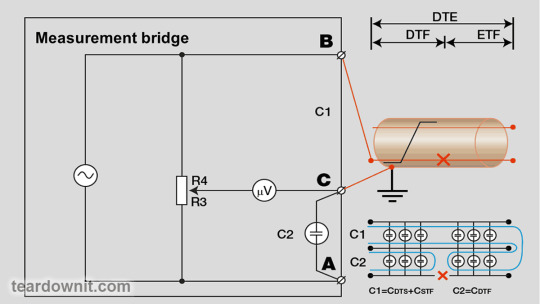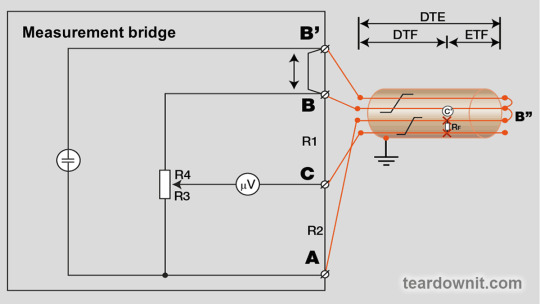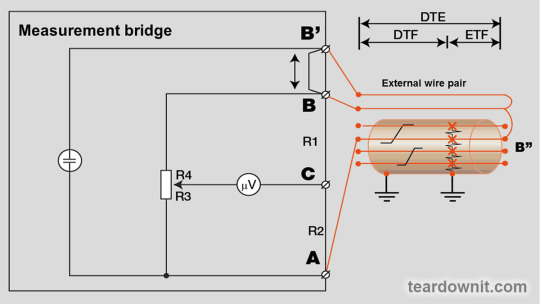#lpair
Text
Measurement мethods: Wheatstone Bridge, Murray Bridge, Hilborn/Graff Bridge, Kupfmüller Bridge.
AC measurements are useful for localizing core breaks. This is best accomplished for shielded cables by measuring each core's capacitance relative to the shield. Knowing the core capacitance C-linear, the length of the broken core can be calculated using the formula: Lpaire = Ccore-shield/C per length

When measuring a broken circuit's core capacitance, the cores of the other circuits in the cable bundle are connected to each other and to a reliably grounded shield. If the capacitance measurement results of both cores are the same, they are broken in the same place. Different values indicate a break in only one core and in the one with the lower capacitance. The distance to the breakage point is calculated by the formula Lpaire = Ccore-shield/C per length, where Ccore-shield and C per length are the measured and the linear capacitance of the core.

It's crucial to remember. Defects in the cable shield have a significant influence on the measurement result. With the help of the above scheme, it is possible to determine the cable screen breakage place. For this purpose, the screen is disconnected from the grounding. Its capacitance relative to the ground is measured on both sides. The breakage place is calculated based on the ratio of the results of these measurements and the cable length (if it is unknown, it is necessary to use measurements for any pair of cores at constant current). The distance to the break is determined approximately - based on the measured capacitance of the shield and its capacitance (it is estimated as 0.083 of the core capacitance relative to the shield).

If the cable is not shielded, the distance to the break can be determined by measuring conductor pair capacitance. However, the Wheatstone bridge circuit does not provide sufficient accuracy. However, even in the case of DC measurements, the Wheatstone scheme is rarely used for fault location.

The Murray Bridge is often preferred because it allows measuring resistance differences between two arms. Thus, for example, the asymmetry at direct current is measured, which is evaluated by the relative value of the resistance difference between the conductors. From the figure, it can be clearly seen that this will be determined using the Murray Bridge. The twisted pair asymmetry at alternating current is measured in the same way.

The same property of the Murray Bridge is also used to localize several other faults. The most common are low insulation resistance, and one of the cores shorted. During measurements, the unknown values of the defect resistance RF and shield resistance Rshield are included in both arms of the bridge, so they are mutually compensated, and their value does not play a role.

At alternating current, the location of a break in one of the pair conductors can be localized with the Murray Bridge much more accurately than the Wheatstone Bridge. Moreover, in this case, the information about the cable core capacitance is not needed - the ratio of capacitances C1 and C2 will indicate the ratio of the distance to the defect to the length of the entire pair.
The measurement scheme for localization of the place with low insulation resistance between the conductors of one pair is more complicated. Here too, the compensation effect of unknown values is used.

In all DC measurement schemes for Murray Bridge, an additional conductor is used in addition to the core with the defect to be localized. It can only be a core of the same pair or one of the free pairs in the same cable because it is essential that the RDTS (resistance of the additional core) is equal to the sum of the resistances RDTF+RSTF for the defective core. Since there is always the possibility of a defect in one core due to poor contact at the splice point of two cable sections, one can only be partially sure of the measurement accuracy.

The Hilborn/Graf Bridge measurement circuit can overcome this drawback. As can be seen from the figure, although the circuit is based on two additional conductors, the contribution of their resistance can be minimized if the ratio R3+R4 >= RDTS is satisfied. Like the Murray Bridge, the Hilborn/Graf bridge is also suitable for localizing the reduced insulation resistance of one or two conductors.
The Hilborn/Graph bridge has other advantages - it is the only way to locate a fault in a cable where all conductors are shorted. Due to the insensitivity to the resistance value of the additional conductors, not only the conductors of the cable in which the fault is to be located but also two other conductors (either a pair of conductors from another cable or a pair of any other conductors) can be used for localization. It is this property of the Hilborn/Graph bridge that ensures a successful search for the place in the cable where all its cores have a low insulation resistance (such a defect occurs, for example, as a result of cores fusion during a lightning strike or a strong short circuit of a cable with paper insulation of cores).

An additional pair of conductors is only sometimes available. A second parallel cable may not be available, and over long distances, it is not economical to run external conductors. This problem is solved by the Kupfmuller bridge measuring circuit: it allows you to do without additional conductors by performing two measurements on an open and a closed circuit. Although the Kupfmuller method imposes restrictions on the parameters of the measuring circuit elements, it is sometimes the last hope - some defects of this kind cannot be localized even with the help of an OTDR because of their "inexpressibility".
Accepted notations
In most cable fault locators, the following intuitive and convenient symbols are used to designate the lengths of the various cable sections with localizable faults, which were chosen for the figures in this article:
DTS = Distance To Strap (distance from the device connection point to the installation point of the jumper at the far end);
DTF = Distance To Fault (distance from the device connection point to the pair fault);
STF = Strap To Fault (distance from the damage point to the place of installation of the jumper at the far end of the pair);
DTE = Distance To End (distance from the device connection point to the twisted pair end);
ETF = End To Fault (distance from the fault location to the cable line end farthest from the device).
1 note
·
View note
Photo

Taking over @Paris with @lpa X @revolve 🇫🇷 1 or 2? Of course I wanted to take a photo in the Arc de Triomph but parisian buildings matched my outfit better I think🤓 or my outfit matched parisian buildings? It’s a matter of perspective 😄 Thanks to @duckanddry for getting me ready for @parisfashionweek after @londonfashionweek ! (Who btw have all blow dries at £20 in their new Old Spitafields branch 👀) my hair was untouched for days! Anyways, I’m back in London! Same old same old! I can’t believe how much I missed it, guess I can finally call it my home now💕 . . . . . #revolve #revolvearoundtheworld #revolveambassador #lpa #lpair #paris #parisfashionweek #pfw #pfw19 #ss20 #parisjetaime #parisfrance #parisian #parisianchic #parisianstyle #parisianlifestyle #vivreparis #arcdetriomphe #toureiffel #topparisphoto #topfrancephoto #parisphoto #parisblogger #parisblog #parisfashion #religionclothing #visitparis #visitparisregion #parisstreetstyle #travelblogger (at Arc de Triomphe) https://www.instagram.com/p/B3FaIisleHE/?igshid=1iy3wfv3jff0u
#revolve#revolvearoundtheworld#revolveambassador#lpa#lpair#paris#parisfashionweek#pfw#pfw19#ss20#parisjetaime#parisfrance#parisian#parisianchic#parisianstyle#parisianlifestyle#vivreparis#arcdetriomphe#toureiffel#topparisphoto#topfrancephoto#parisphoto#parisblogger#parisblog#parisfashion#religionclothing#visitparis#visitparisregion#parisstreetstyle#travelblogger
0 notes
Photo

If you would like to chill and enjoy the view of Champs de Mars from the Eiffel Tower and basically the entire city of Paris just like me go to my previous post 💃🏻 But don’t forget to like this one lol Have a fantastic Friday y’all! . . . . . #paris #parisfrance #latoureiffel #toureiffel #eiffel #eiffeltower #paristourisme #paristour #parisphoto #topparisphoto #topeiffeltowerphoto #parisjetaime #hello_france #vivreparis #parisian #parisnightlife #parisnights #parisnight #midnightinparis #travelblogger #dametraveler #damestravel #iamtb #beautifuldestinations #wonderful_places #lpair #citywonderstours #citywonders #parisianstyle #revolvearoundtheworld (at Tour Eiffel) https://www.instagram.com/p/B3NDoFzlGE7/?igshid=2wjjvfd8bbcg
#paris#parisfrance#latoureiffel#toureiffel#eiffel#eiffeltower#paristourisme#paristour#parisphoto#topparisphoto#topeiffeltowerphoto#parisjetaime#hello_france#vivreparis#parisian#parisnightlife#parisnights#parisnight#midnightinparis#travelblogger#dametraveler#damestravel#iamtb#beautifuldestinations#wonderful_places#lpair#citywonderstours#citywonders#parisianstyle#revolvearoundtheworld
2 notes
·
View notes